
A Microchip Technology Company
©2011 Silicon Storage Technology, Inc.
DS25085A
10/11
Data Sheet
www.microchip.com
Features
• Firmware Hub for Intel 8xx Chipsets
• 8 Mbit SuperFlash memory array for code/data
storage
– 1024K x8
• Flexible Erase Capability
– Uniform 4 KByte Sectors
– Uniform 64 KByte overlay blocks
– 64 KByte Top Boot Block protection
– Chip-Erase for PP Mode Only
• Single 3.0-3.6V Read and Write Operations
• Superior Reliability
– Endurance:100,000 Cycles (typical)
– Greater than 100 years Data Retention
• Low Power Consumption
– Active Read Current: 6 mA (typical)
– Standby Current: 10 µA (typical)
• Fast Sector-Erase/Byte-Program Operation
– Sector-Erase Time: 18 ms (typical)
– Block-Erase Time: 18 ms (typical)
– Chip-Erase Time: 70 ms (typical)
– Byte-Program Time: 14 µs (typical)
– Chip Rewrite Time: 15 seconds (typical)
– Single-pulse Program or Erase
– Internal timing generation
• Two Operational Modes
– Firmware Hub Interface (FWH) Mode for
In-System operation
– Parallel Programming (PP) Mode for fast
production programming
• Firmware Hub Hardware Interface Mode
– 5-signal communication interface supporting byte Read
and Write
– 33 MHz clock frequency operation
– WP# and TBL# pins provide hardware write
protect for entire chip and/or top Boot Block
– Block Locking Register for all blocks
– Standard SDP Command Set
– Data# Polling and Toggle Bit for End-of-Writedetection
– 5 GPI pins for system design flexibility
– 4 ID pins for multi-chip selection
• Parallel Programming (PP) Mode
– 11-pin multiplexed address and
8-pin data I/O interface
– Supports fast In-System or PROM programming for
manufacturing
• CMOS and PCI I/O Compatibility
• Packages Available
– 32-lead PLCC
– 32-lead TSOP (8mm x 14mm)
– 40-lead TSOP (10mm x 20mm)
– Non-Pb (lead-free) packages available
• All non-Pb (lead-free) devices are RoHS compliant
8 Mbit Firmware Hub
SST49LF008A
The SST49LF008A flash memory devices are designed to be read-compatible
with the Intel® 82802 Firmware Hub (FWH) device for PC-BIOS application.
These devices provide protection for the storage and update of code and data in
addition to adding system design flexibility through five general purpose inputs.
Two interface modes are supported by the SST49LF008A: Firmware Hub (FWH)
Interface mode for in-system programming and Parallel Programming (PP) mode
for fast factory programming of PC-BIOS applications.

©2011 Silicon Storage Technology, Inc.
DS25085A
10/11
2
8 Mbit Firmware Hub
SST49LF008A
Data Sheet
A Microchip Technology Company
Product Description
The SST49LF008A flash memory devices are designed to be read-compatible with the Intel® 82802
Firmware Hub (FWH) device for PC-BIOS application. These devices provide protection for the storage
and update of code and data in addition to adding system design flexibility through five general pur-
pose inputs. Two interface modes are supported by the SST49LF008A: Firmware Hub (FWH) Interface
mode for in-system programming and Parallel Programming (PP) mode for fast factory programming of
PC-BIOS applications.
The SST49LF008A flash memory devices are manufactured with SST’s proprietary, high performance
SuperFlash technology. The split-gate cell design and thick-oxide tunneling injector attain better reli-
ability and manufacturability compared with alternate approaches. The SST49LF008A devices signifi-
cantly improve performance and reliability, while lowering power consumption.
The SST49LF008A devices write (Program or Erase) with a single 3.0-3.6V power supply. They use
less energy during Erase and Program than alternative flash memory technologies. The total energy
consumed is a function of the applied voltage, current and time of application. Since for any given volt-
age range, the SuperFlash technology uses less current to program and has a shorter Erase time, the
total energy consumed during any Erase or Program operation is less than alternative flash memory
technologies. The SST49LF008A products provide a maximum Byte-Program time of 20 µsec. The
entire memory can be erased and programmed byte-by-byte typically in 15 seconds when using status
detection features such as Toggle Bit or Data# Polling to indicate the completion of Program operation.
The SuperFlash technology provides fixed Erase and Program times independent of the number of
Erase/Program cycles performed. Therefore the system software or hardware does not have to be cal-
ibrated or correlated to the cumulated number of Erase/Program cycles as is necessary with alterna-
tive flash memory technologies, whose Erase and Program time increase with accumulated Erase/
Program cycles.
To protect against inadvertent write, the SST49LF008A devices employ hardware and software data
(SDP) protection schemes. It is offered with typical endurance of 100,000 cycles. Data retention is
rated at greater than 100 years.
To meet high density, surface mount requirements, the SST49LF008A devices are offered in a 32-lead
TSOP package. In addition, the SST49LF008A is offered in 32-lead PLCC and 40-lead TSOP pack-
ages. See Figures 2, 3, and 4 for pin assignments and Table 1 for pin descriptions.
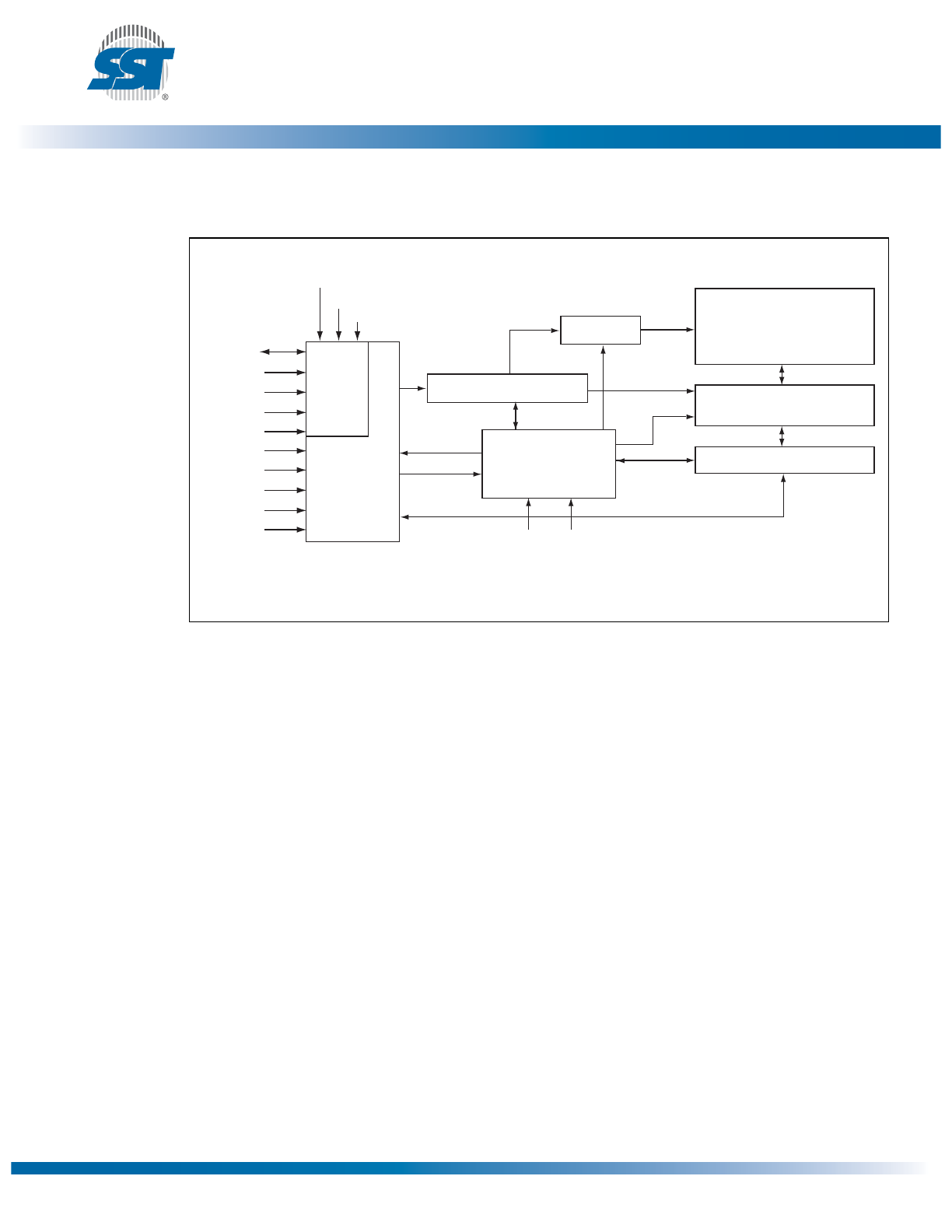
©2011 Silicon Storage Technology, Inc.
DS25085A
10/11
3
8 Mbit Firmware Hub
SST49LF008A
Data Sheet
A Microchip Technology Company
Functional Block Diagram
Figure 1: Functional Block Diagram
1161 B1.2
Y-Decoder
I/O Buffers and Data Latches
Address Buffers Latches
X-Decoder
SuperFlash
Memory
Control Logic
CLK
RST#
IC
FGPI[4:0]
Programmer
Interface
WP#
TBL#
INIT#
ID[3:0]
FWH4
R/C#
OE#
WE#
A[10:0]
DQ[7:0]
FWH[3:0]
FWH
Interface
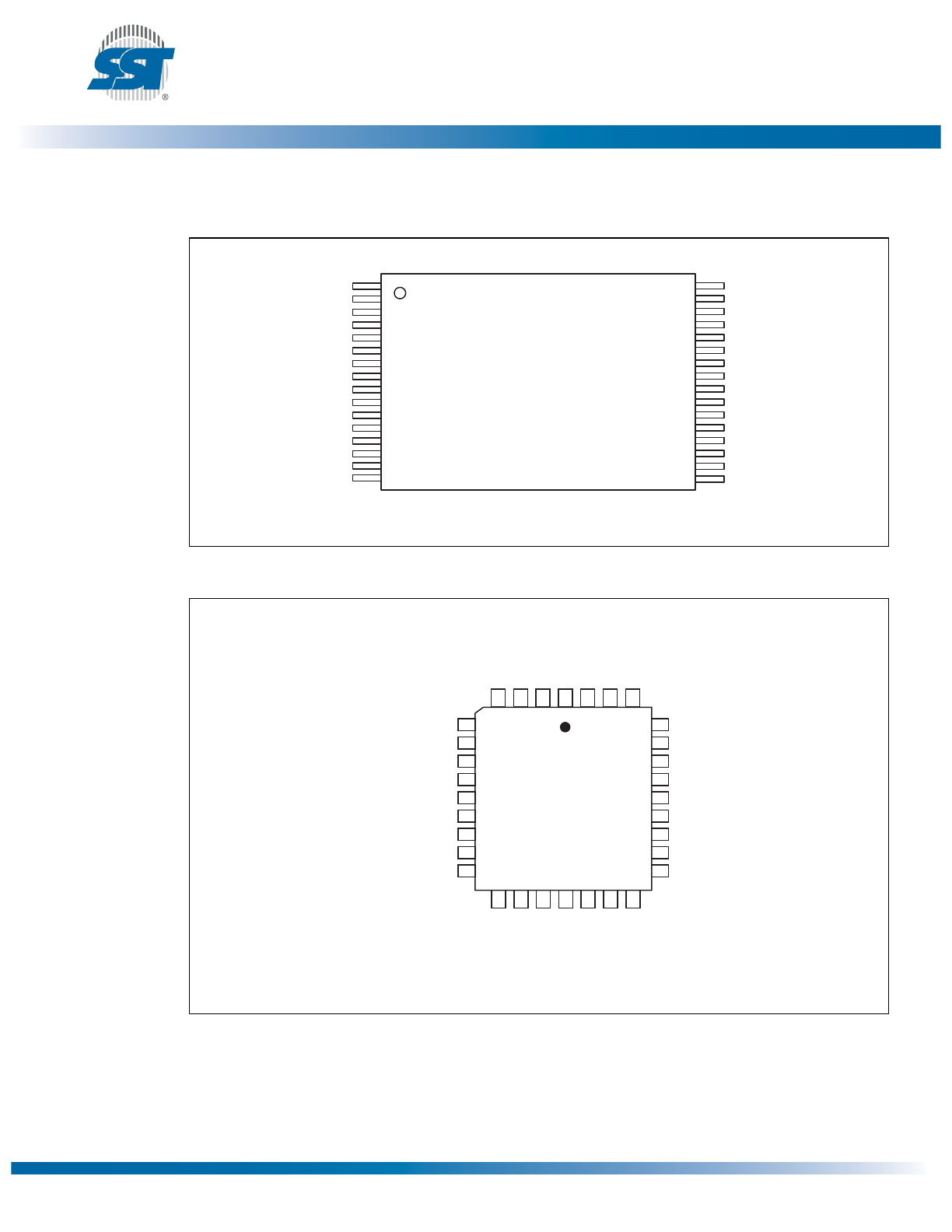
©2011 Silicon Storage Technology, Inc.
DS25085A
10/11
4
8 Mbit Firmware Hub
SST49LF008A
Data Sheet
A Microchip Technology Company
Pin Assignments
Figure 2: Pin Assignments for 32-lead TSOP (8mm x 14mm)
Figure 3: Pin Assignments for 32-lead PLCC
NC
NC
NC
VSS (VSS)
IC (IC)
A10 (FGPI4)
R/C# (CLK)
VDD (VDD)
NC
RST# (RST#)
A9 (FGPI3)
A8 (FGPI2)
A7 (FGPI1)
A6 (FGPI0)
A5 (WP#)
A4 (TBL#)
1
2
3
4
5
6
7
8
9
10
11
12
13
14
15
16
OE# (INIT#)
WE# (FWH4)
VDD (VDD)
DQ7 (RES)
DQ6 (RES)
DQ5 (RES)
DQ4 (RES)
DQ3 (FWH3)
VSS (VSS)
DQ2 (FWH2)
DQ1 (FWH1)
DQ0 (FWH0)
A0 (ID0)
A1 (ID1)
A2 (ID2)
A3 (ID3)
32
31
30
29
28
27
26
25
24
23
22
21
20
19
18
17
1161 32-tsop P1.0
Standard Pinout
Top View
Die Up
( ) Designates FWH Mode
5
6
7
8
9
10
11
12
13
29
28
27
26
25
24
23
22
21
A7(FGPI1)
A6 (FGPI0)
A5 (WP#)
A4 (TBL#)
A3 (ID3)
A2 (ID2)
A1 (ID1)
A0 (ID0)
DQ0 (FWH0)
IC (IC)
VSS (VSS)
NC
NC
VDD (VDD)
OE# (INIT#)
WE# (FWH4)
NC
DQ7 (RES)
4
3
2
1
32
31 30
A8
(FGPI2)
A9
(FGPI3)
RST#
(RST#)
NC
V
DD
(V
DD
)
R/C#
(CLK)
A10
(FGPI4)
32-lead PLCC
Top View
1161 32-plcc P2.3
14
15
16
17 18
19
20
DQ1
(FWH1)
DQ2
(FWH2)
V
SS
(V
SS
)
DQ3
(FWH3)
DQ4
(RES)
DQ5
(RES)
DQ6
(RES)
( ) Designates FWH Mode
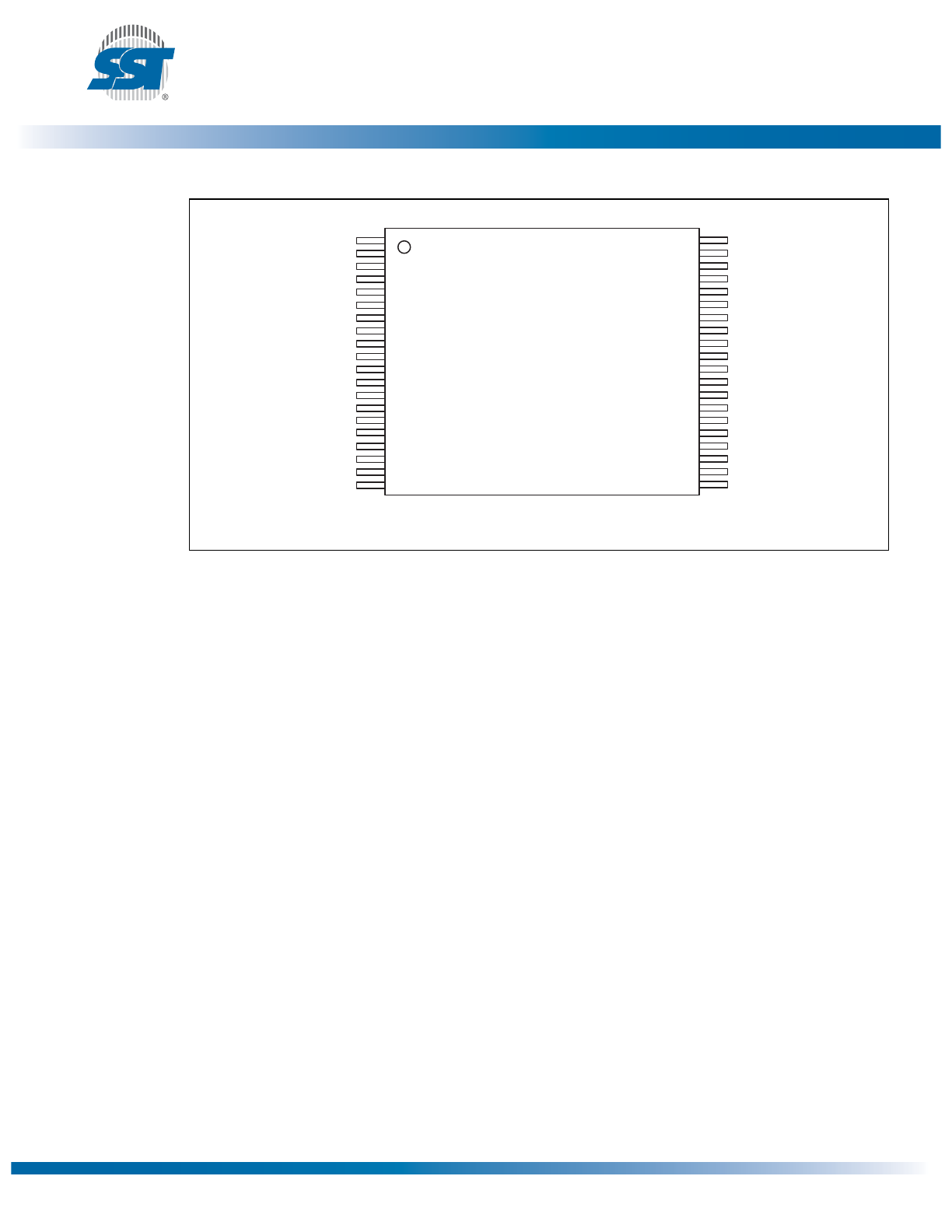
©2011 Silicon Storage Technology, Inc.
DS25085A
10/11
5
8 Mbit Firmware Hub
SST49LF008A
Data Sheet
A Microchip Technology Company
Figure 4: Pin Assignments for 40-lead TSOP
1
2
3
4
5
6
7
8
9
10
11
12
13
14
15
16
17
18
19
20
40
39
38
37
36
35
34
33
32
31
30
29
28
27
26
25
24
23
22
21
1232 40-tsop P1.0
Standard Pinout
Top View
Die Up
NC (NC)
IC (IC)
NC (NC)
NC (NC)
NC (NC)
NC (NC)
A10 (FGPI4)
NC (NC)
R/C# (CLK)
VDD
NC (NC)
RST# (RST#)
NC (NC)
NC (NC)
A9 (FGPI3)
A8 (FGPI2)
A7 (FGPI1)
A6 (FGPI0)
A5 (WP#)
A4 (TBL#)
VSS
VDD
(FWH4) WE#
(INIT#) OE#
(NC) NC
(RES) DQ7
(RES) DQ6
(RES) DQ5
(RES) DQ4
(NC) NC
VSS
VSS
(FWH3) DQ3
(FWH2) DQ2
(FWH1) DQ1
(FWH0) DQ0
(ID0) A0
(ID1) A1
(ID2) A2
(ID3) A3
( ) Designates FWH Mode
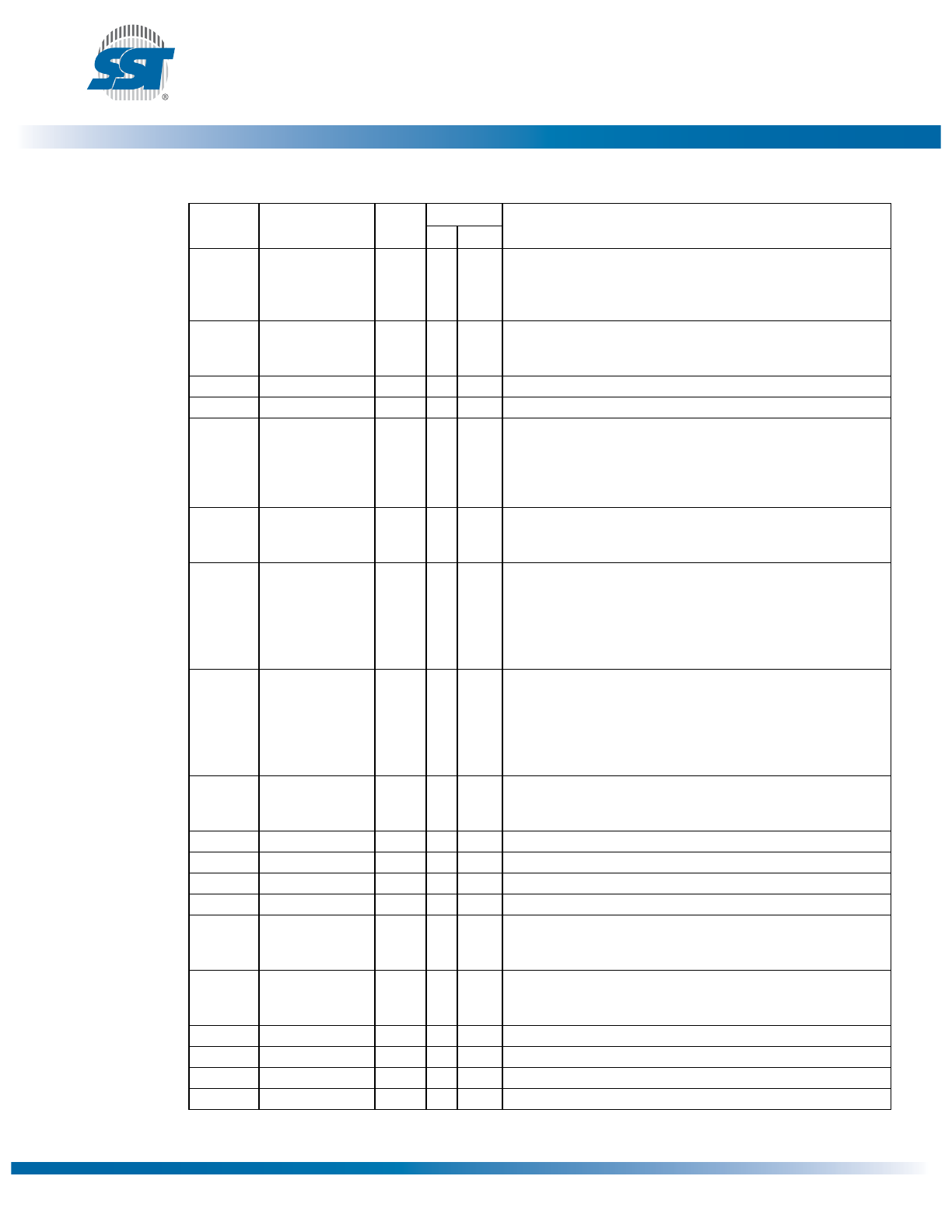
©2011 Silicon Storage Technology, Inc.
DS25085A
10/11
6
8 Mbit Firmware Hub
SST49LF008A
Data Sheet
A Microchip Technology Company
Table 1: Pin Description
Symbol
Pin Name
Type
1
Interface
Functions
PP FWH
A
10
-A
0
Address
I
X
Inputs for low-order addresses during Read and Write opera-
tions. Addresses are internally latched during a Write cycle. For
the programming interface, these addresses are latched by R/
C# and share the same pins as the high-order address inputs.
DQ
7
-DQ
0
Data
I/O
X
To output data during Read cycles and receive input data during
Write cycles. Data is internally latched during a Write cycle. The
outputs are in tri-state when OE# is high.
OE#
Output Enable
I
X
To gate the data output buffers
WE#
Write Enable
I
X
To control the Write operations
IC
Interface
Configuration
Pin
I
X
X
This pin determines which interface is operational. When held
high, programmer mode is enabled and when held low, FWH
mode is enabled. This pin must be setup at power-up or before
return from reset and not change during device operation. This pin
is internally pulled- down with a resistor between 20-100 K
INIT#
Initialize
I
X
This is the second reset pin for in-system use. This pin is inter-
nally combined with the RST# pin; If this pin or RST# pin is
driven low, identical operation is exhibited.
ID[3:0]
Identification
Inputs
I
X
These four pins are part of the mechanism that allows multiple
parts to be attached to the same bus. The strapping of these
pins is used to identify the component.The boot device must
have ID[3:0]=0000 and it is recommended that all subsequent
devices should use sequential up-count strapping. These pins
are internally pulled-down with a resistor between 20-100 K
FGPI[4:0] General Pur-
pose Inputs
I
X
These individual inputs can be used for additional board flexibil-
ity. The state of these pins can be read through GPI_REG regis-
ter. These inputs should be at their desired state before the start
of the PCI clock cycle during which the read is attempted, and
should remain in place until the end of the Read cycle. Unused
GPI pins must not be floated.
TBL#
Top Block Lock
I
X
When low, prevents programming to the Boot Block sectors at top of
memory. When TBL# is high it disables hardware write protection for
the top block sectors. This pin cannot be left unconnected.
FWH[3:0] FWH I/Os
I/O
X
I/O Communications
CLK
Clock
I
X
To provide a clock input to the control unit
FWH4
FWH Input
I
X
Input Communications
RST#
Reset
I
X
X
To reset the operation of the device
WP#
Write Protect
I
X
When low, prevents programming to all but the highest address-
able blocks. When WP# is high it disables hardware write protec-
tion for these blocks. This pin cannot be left unconnected.
R/C#
Row/Column
Select
I
X
Select For the Programming interface, this pin determines whether
the address pins are pointing to the row addresses, or to the column
addresses.
RES
Reserved
X
These pins must be left unconnected.
V
DD
Power Supply
PWR
X
X
To provide power supply (3.0-3.6V)
V
SS
Ground
PWR
X
X
Circuit ground (OV reference) All V
SS
pins must be grounded.
NC
No Connection
I
X
X
Unconnected pins
T1.4 25085
1. I = Input, O = Output
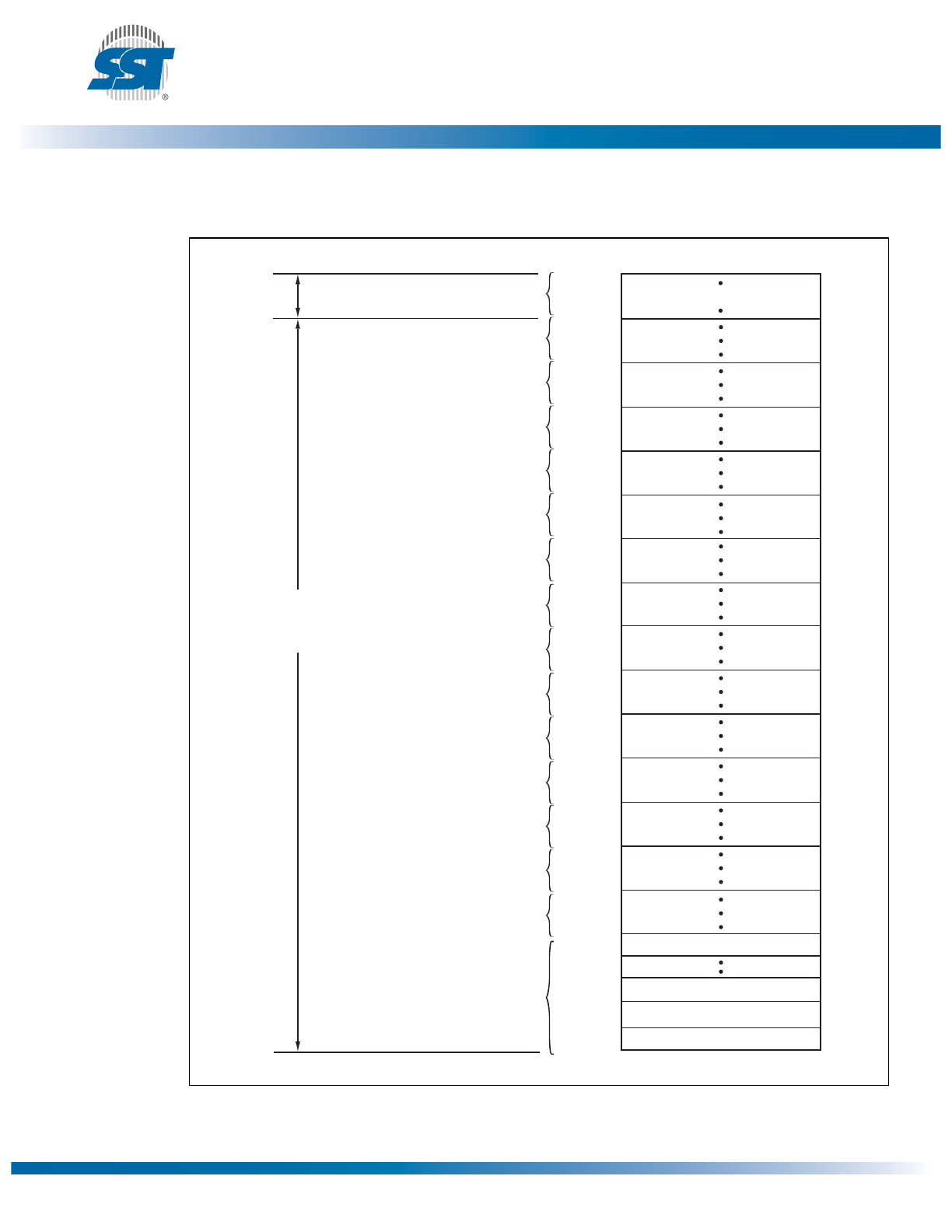
©2011 Silicon Storage Technology, Inc.
DS25085A
10/11
7
8 Mbit Firmware Hub
SST49LF008A
Data Sheet
A Microchip Technology Company
Device Memory Map
Figure 5: Device Memory Map for SST49LF008A
0FFFFFH
0F0000H
0EFFFFH
0E0000H
0DFFFFH
0D0000H
0CFFFFH
0C0000H
0BFFFFH
0B0000H
0AFFFFH
0A0000H
09FFFFH
090000H
08FFFFH
080000H
07FFFFH
070000H
06FFFFH
060000H
05FFFFH
050000H
04FFFFH
040000H
03FFFFH
030000H
02FFFFH
020000H
01FFFFH
010000H
00FFFFH
Block 7
Block 8
Block 6
Block 5
Block 4
Block 3
Block 2
Block 1
Block 15
Block 14
Block 13
Block 12
Block 11
Block 10
Block 9
Block 0
(64 KByte)
1161 F08.0
WP# for
Block 0 14
TBL#
4 KByte Sector 1
4 KByte Sector 2
4 KByte Sector 15
4 KByte Sector 0
Boot Block
002000H
001000H
000000H
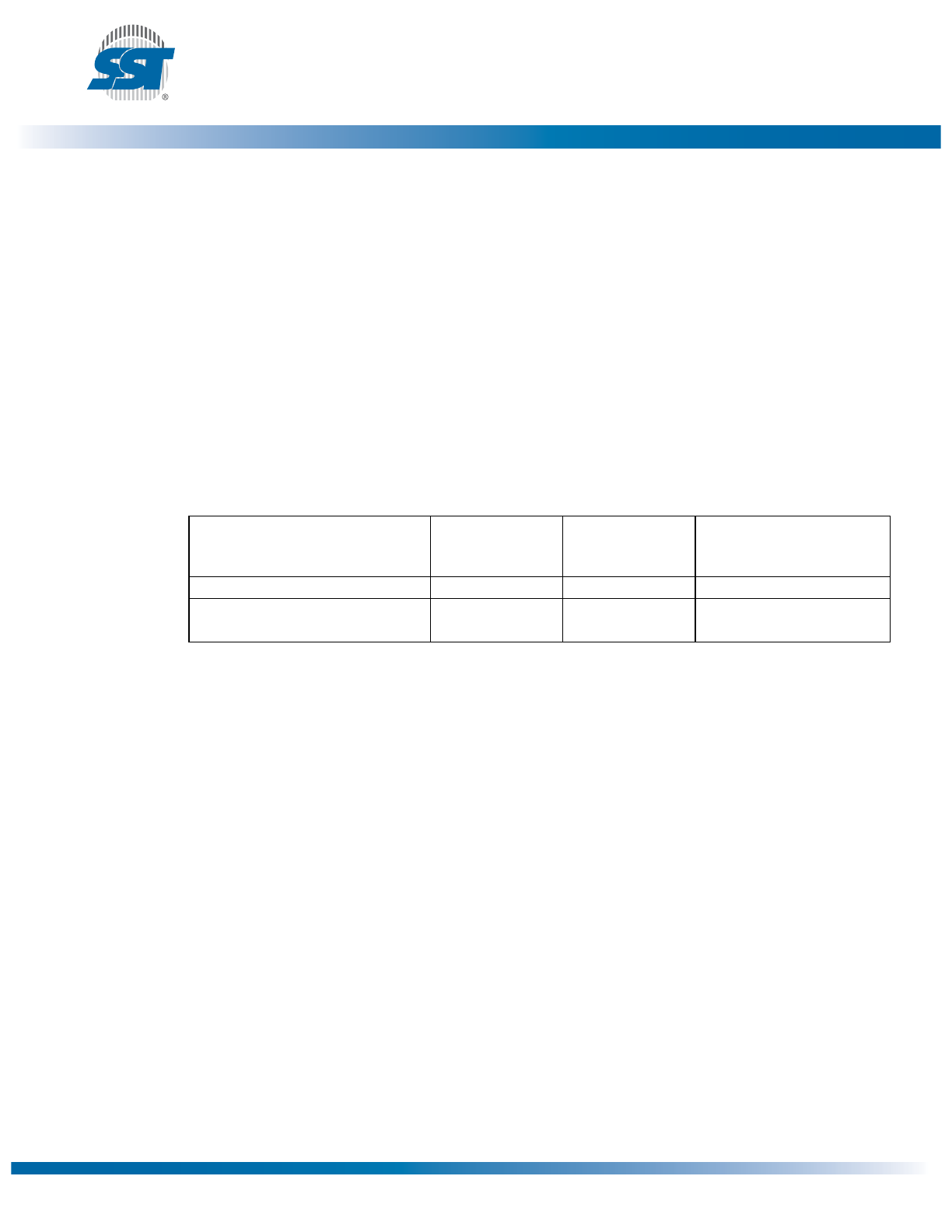
©2011 Silicon Storage Technology, Inc.
DS25085A
10/11
8
8 Mbit Firmware Hub
SST49LF008A
Data Sheet
A Microchip Technology Company
Design Considerations
SST recommends a high frequency 0.1 µF ceramic capacitor to be placed as close as possible
between V
DD
and V
SS
less than 1 cm away from the V
DD
pin of the device. Additionally, a low fre-
quency 4.7 µF electrolytic capacitor from V
DD
to V
SS
should be placed within 1 cm of the V
DD
pin. If you
use a socket for programming purposes add an additional 1-10 µF next to each socket.
The RST# pin must remain stable at V
IH
for the entire duration of an Erase operation. WP# must
remain stable at V
IH
for the entire duration of the Erase and Program operations for non-Boot Block
sectors. To write data to the top Boot Block sectors, the TBL# pin must also remain stable at V
IH
for the
entire duration of the Erase and Program operations.
Product Identification
The product identification mode identifies the device as the SST49LF008A and manufacturer as SST.
Mode Selection
The SST49LF008A flash memory devices can operate in two distinct interface modes: the Firmware
Hub Interface (FWH) mode and the Parallel Programming (PP) mode. The IC (Interface Configuration
pin) is used to set the interface mode selection. If the IC pin is set to logic High, the device is in PP
mode; while if the IC pin is set Low, the device is in the FWH mode. The IC selection pin must be con-
figured prior to device operation. The IC pin is internally pulled down if the pin is not connected. In
FWH mode, the device is configured to interface with its host using Intel’s Firmware Hub proprietary
protocol. Communication between Host and the SST49LF008A occurs via the 4-bit I/O communication
signals, FWH [3:0] and the FWH4. In PP mode, the device is programmed via an 11-bit address and
an 8-bit data I/O parallel signals. The address inputs are multiplexed in row and column selected by
control signal R/C# pin. The column addresses are mapped to the higher internal addresses, and the
row addresses are mapped to the lower internal addresses. See the Device Memory Map in Figure 5
for address assignments.
Table 2: Product Identification
Byte
Data
JEDEC ID
Address
Location
Manufacturer’s ID
0000H
BFH
FFBC0000H
Device ID
SST49LF008A
0001H
5AH
FFBC0001H
T2.7 25085

©2011 Silicon Storage Technology, Inc.
DS25085A
10/11
9
8 Mbit Firmware Hub
SST49LF008A
Data Sheet
A Microchip Technology Company
Firmware Hub (FWH) Mode
Device Operation
The FWH mode uses a 5-signal communication interface, FWH[3:0] and FWH4, to control operations
of the SST49LF008A. Operations such as Memory Read and Memory Write uses Intel FWH propriety
protocol. JEDEC Standard SDP (Software Data Protection) Byte-Program, Sector-Erase and Block-
Erase command sequences are incorporated into the FWH memory cycles. Chip-Erase is only avail-
able in PP Mode.
The device enters standby mode when FWH4 is high and no internal operation is in progress. The
device is in ready mode when FWH4 is low and no activity is on the FWH bus.
Firmware Hub Interface Cycles
Addresses and data are transferred to and from the SST49LF008A by a series of “fields,” where each
field contains 4 bits of data. SST49LF008A supports only single-byte Read and Write, and all fields are
one clock cycle in length. Field sequences and contents are strictly defined for Read and Write opera-
tions. Addresses in this section refer to addresses as seen from the SST49LF008A’s “point of view,”
some calculation will be required to translate these to the actual locations in the memory map (and
vice versa) if multiple memory devices are used on the bus. Tables 3 and 4 list the field sequences for
Read and Write cycles.
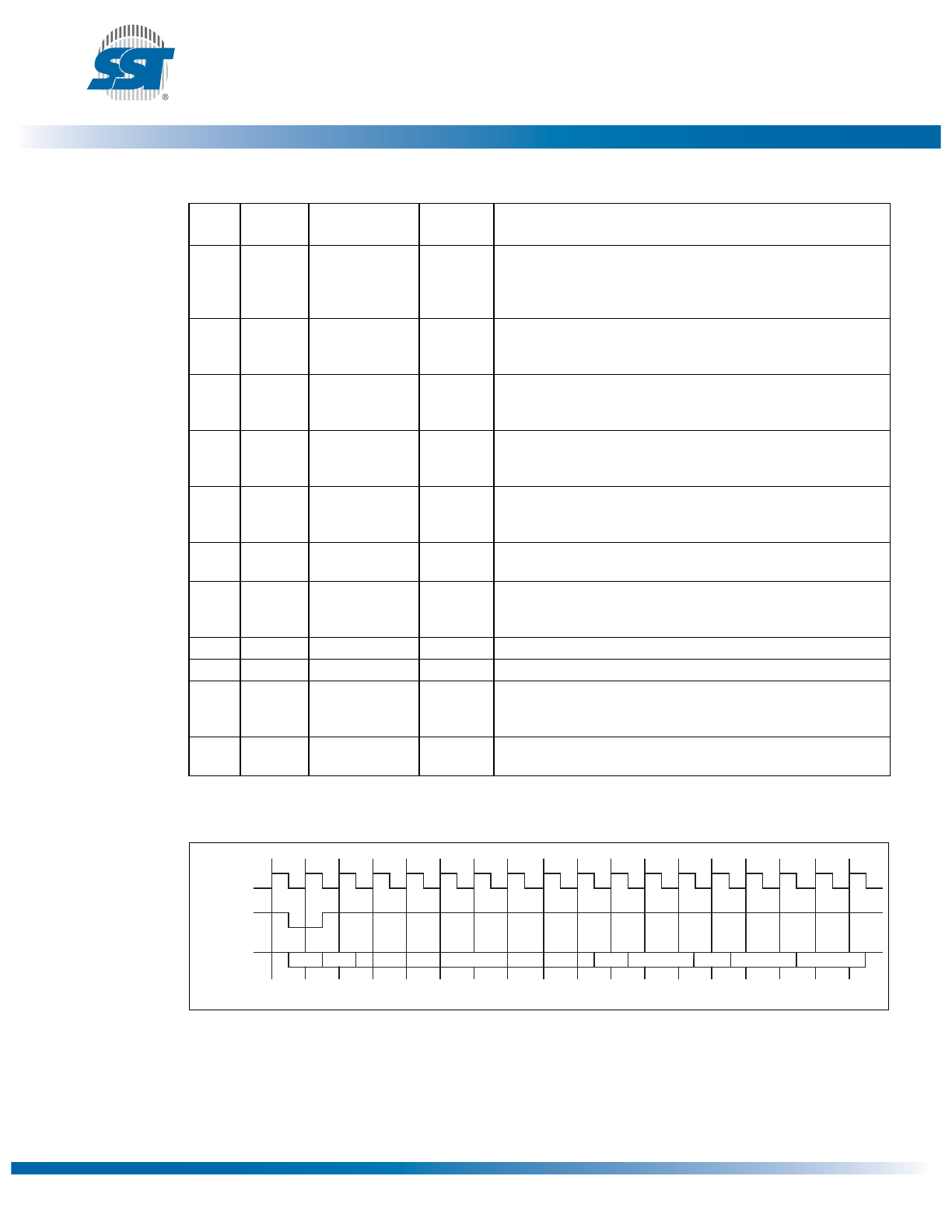
©2011 Silicon Storage Technology, Inc.
DS25085A
10/11
10
8 Mbit Firmware Hub
SST49LF008A
Data Sheet
A Microchip Technology Company
Figure 6: Single-Byte Read Waveforms
Table 3: FWH Read Cycle
Clock
Cycle
Field
Name
Field Contents
FWH[3:0]
1
FWH[3:0]
Direction
Comments
1
START
1101
IN
FWH4 must be active (low) for the part to respond. Only the
last start field (before FWH4 transitions high) should be recog-
nized. The START field contents indicate a FWH memory
Read cycle.
2
IDSEL
0000 to 1111
IN
Indicates which FWH device should respond. If the to IDSEL (ID
select) field matches the value ID[3:0], then that particular device will
respond to the whole bus cycle.
3-9
IMADDR
YYYY
IN
These seven clock cycles make up the 28-bit memory address.
YYYY is one nibble of the entire address. Addresses are trans-
ferred most-significant nibble first.
10
IMSIZE
0000 (1 byte)
IN
A field of this size indicates how many bytes will be or trans-
ferred during multi-byte operations. The SST49LF008A will only
support single-byte operation. IMSIZE=0000b
11
TAR0
1111
IN
then Float
In this clock cycle, the master (Intel ICH) has driven the bus
then float to all ‘1’s and then floats the bus, prior to the next
clock cycle. This is the first part of the bus “turnaround cycle.”
12
TAR1
1111 (float)
Float
then OUT
The SST49LF008A takes control of the bus during this cycle.
During the next clock cycle, it will be driving “sync data.”
13
RSYNC
0000 (READY)
OUT
During this clock cycle, the FWH will generate a “ready-sync”
(RSYNC) indicating that the least-significant nibble of the least-
significant byte will be available during the next clock cycle.
14
DATA
YYYY
OUT
YYYY is the least-significant nibble of the least-significant data byte.
15
DATA
YYYY
OUT
YYYY is the most-significant nibble of the least-significant data byte.
16
TAR0
1111
OUT
then Float
In this clock cycle, the SST49LF008A has driven the bus to all
ones and then floats the bus prior to the next clock cycle. This
is the first part of the bus “turnaround cycle.”
17
TAR1
1111 (float)
Float then
IN
The master (Intel ICH) resumes control of the bus during this
cycle.
T3.3 25085
1. Field contents are valid on the rising edge of the present clock cycle.
CLK
FWH4
FWH[3:0]
1161 F09.0
STR
TAR
RSYNC
IMS
IMADDR
IDS
DATA
TAR
